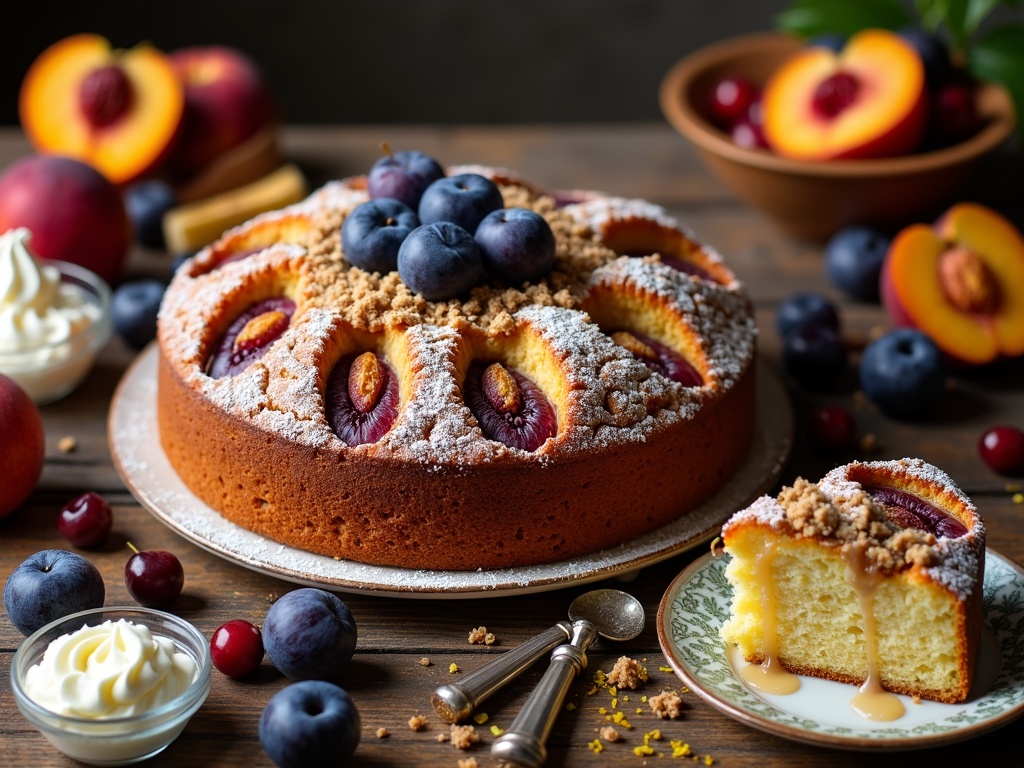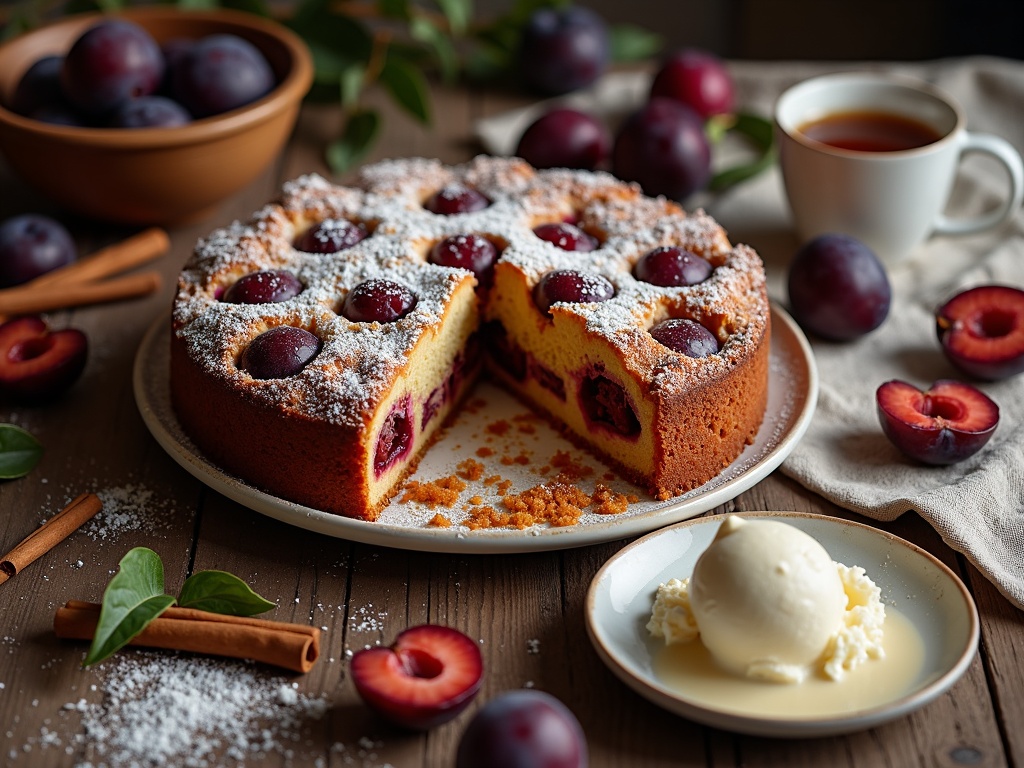Traditional plum cake stands among the most delicious fruity desserts, offering the ideal mix of dense, tender cake and jammy, tangy-sweet plum pockets that burst with flavor in each bite. This adaptable dessert serves perfectly as a focal point during holidays and celebrations, getting better with time as moisture from the plums seeps throughout the cake.
Find In This Article
Key Takeaways
- The cake gets its unique texture from the combination of buttery crumb and plums that transform into concentrated pockets of flavor during baking.
- Selecting properly ripened plums is crucial — they should yield slightly to pressure but still be firm enough to slice cleanly.
- The cake can be prepared 1–2 days in advance, as the flavors actually improve with time, making it an excellent make-ahead dessert option.
- Common mistakes include using underripe plums, overmixing the batter, and not properly testing for doneness.
- The versatile base recipe can be adapted with different stone fruits, spice variations, or additions like streusel topping or almond extract.
Why You’ll Love This Traditional Plum Cake
I’ve found that traditional plum cake holds a special place among fruity dessert recipes for good reason. This delightful treat combines rich, moist cake with juicy plums in a way that makes each bite memorable.
Perfect Texture and Flavor Profile
The texture of a well-made plum cake is simply divine—dense yet tender, with a buttery crumb that melts in your mouth. What makes this cake stand out is how the plums transform during baking. They soften into jammy pockets throughout the cake, creating little bursts of tangy-sweet flavor that contrast beautifully with the rich batter.
Unlike lighter cakes, this traditional recipe develops a deeper flavor profile thanks to:
- Brown sugar and warm spices that create a caramelized quality
- Plums that become more concentrated and intense when baked
- Natural moisture from the fruit that keeps the cake fresh for days
The balance between the cake’s sweetness and the plums’ natural tartness creates a complexity that’s hard to find in other desserts. It’s similar to what makes a good Black Forest gateau so memorable, though with a different fruit star.
Perfect for Celebrations and Beyond
I’ve served plum cake at countless gatherings, and it always receives rave reviews. This versatile treat shines as a centerpiece dessert during holidays like Christmas and Thanksgiving, where its rustic charm and rich flavors complement festive meals beautifully.
What’s particularly convenient about plum cake is its impressive shelf life. I often bake it 1–2 days before serving, as the flavors actually improve with time. The moisture from the plums continues to permeate the cake, making it even more delicious.
For longer storage, you can freeze plum cake for up to three months with minimal quality loss. Simply wrap individual slices or the entire cake in plastic wrap and aluminum foil. This make-ahead quality puts it in the same convenient category as favorites like Biscoff cheesecake or rhubarb crumble.
The versatility extends to how you serve it too. I love it slightly warm with a dollop of whipped cream for dessert, but it’s equally good at room temperature alongside afternoon tea or coffee. For a more indulgent treat, try it with vanilla ice cream, similar to how you might enjoy a fresh peach crisp.
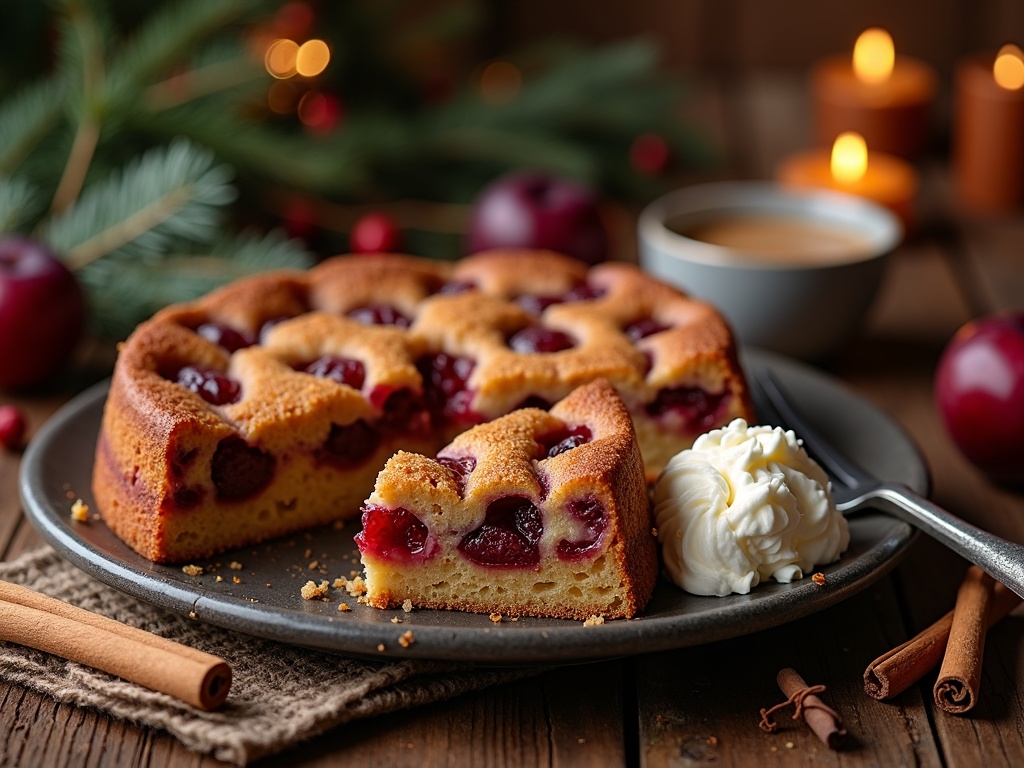
Essential Ingredients for Your Plum Cake
When making a delicious plum cake, the quality of ingredients makes all the difference in achieving that perfect balance of sweet, tart, and spice. I’ve found that selecting the right components ensures your cake turns out moist, flavorful, and utterly irresistible.
Key Ingredients and Selection Tips
Fresh ripe plums are the star of this show. I look for fruits that yield slightly to gentle pressure – they should feel heavy for their size and have smooth, unblemished skin with a slight give when touched. For the best flavor, I prefer to use plums that are fully ripe but still firm enough to slice cleanly. When preparing them, I remove the pits and slice them into even wedges, which helps them cook uniformly throughout the cake.
All-purpose flour provides the structure for your cake. Make sure to measure it correctly by spooning it into measuring cups and leveling with a knife – this prevents the dense texture that comes from packing too much flour.
Softened butter contributes richness and moisture. The key word here is “softened” – it should yield to gentle pressure but still hold its shape. Cold butter won’t incorporate properly, while melted butter alters the cake’s texture.
Granulated sugar balances the tartness of plums while helping create that golden, slightly crisp exterior. I sometimes sprinkle extra on top before baking for an irresistible sweet crunch.
Eggs act as binding agents and add moisture. I always recommend using room-temperature eggs for best incorporation into the batter.
Vanilla extract brings depth and warmth to complement the fruit. Pure vanilla extract, rather than imitation, delivers superior flavor that enhances the homemade desserts experience.
Baking powder ensures your cake rises properly. Always check that it’s fresh – old baking powder loses its effectiveness and results in flat, dense cakes.
Salt might seem insignificant, but it’s crucial for enhancing the other flavors. Even in sweet bakes, a pinch of salt brings everything into focus.
Ground cinnamon adds that classic warm spice note that pairs perfectly with plums. I find it creates a wonderful aroma that makes the fruit-based dessert feel cozy and inviting.
The magic of plum cake comes from how these simple ingredients work together. The butter and sugar cream together to trap air, resulting in a tender crumb. The flour provides structure while the eggs bind everything together. Meanwhile, the juices from the plums release during baking, creating moist pockets throughout the cake.
Ingredient Variations and Enhancements
For variations on the classic recipe, consider these ingredient adjustments:
- Swap half the all-purpose flour for whole wheat for a nuttier taste
- Add almond extract alongside vanilla for a complementary flavor
- Include brown sugar for deeper caramel notes
- Mix in chopped nuts for texture contrast
- Try cardamom or nutmeg instead of cinnamon for different spice profiles
The beauty of plum cake lies in its versatility, just like other fruit desserts such as peach crisp or strawberry shortcake. By understanding how each ingredient contributes to the final result, you can adapt the recipe to suit your preference.
For a richer dessert experience similar to Black Forest gateau or Biscoff cheesecake, consider adding layers of complexity through additional ingredients like almond meal, sour cream, or even a splash of amaretto liqueur.
Choosing the Right Type of Plums
When selecting plums, I’ve found that different varieties produce unique results:
- Italian prune plums offer a sweet-tart balance
- Red plums provide vibrant color
- Black plums deliver deeper flavor
Don’t be afraid to mix varieties for visual interest and complex taste.
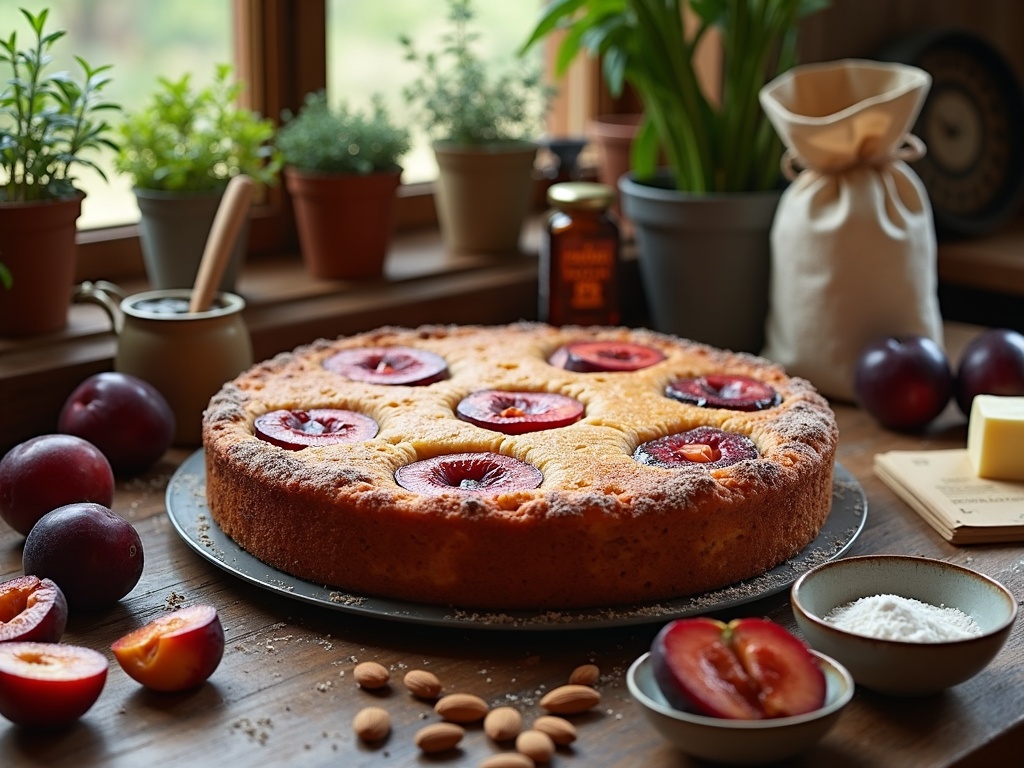
Step-by-Step Baking Guide
Creating a perfect plum cake is all about following a clear process. I’ve broken down this delicious fruit-based dessert into manageable steps that will help you achieve bakery-quality results at home.
Mastering the Plum Cake Process
First, preheat your oven to 350°F (175°C) and prepare your cake pan. I recommend greasing a 9-inch springform pan and lining the bottom with parchment paper. The springform design makes removing the finished cake much easier, especially with the fruit topping.
Next, cream the butter and sugar together in a large mixing bowl until the mixture becomes light and fluffy. This typically takes 3–4 minutes with an electric mixer. Don’t rush this step—proper creaming creates air pockets that give your cake its tender texture.
Add eggs one at a time, beating well after each addition. This gradual incorporation prevents the batter from curdling. Then mix in the vanilla extract until just combined for that classic warmth that complements the plums beautifully.
In a separate bowl, mix your dry ingredients:
- flour
- baking powder
- salt
- and any spices like cinnamon or cardamom that pair wonderfully with plums
Whisking these together ensures even distribution of the leavening agents.
Combine the wet and dry mixtures, alternating additions and mixing gently after each. Start and end with the dry ingredients, adding about a third of each mixture at a time. Mix until just combined—overmixing develops gluten, resulting in a tough cake texture rather than the tender crumb we’re aiming for.
Now for the star ingredient! Arrange your halved or sliced plums on top of the batter in a circular pattern. I find that placing them skin-side down creates the most attractive presentation, but skin-side up intensifies the plum flavor. You can sprinkle a bit of sugar and cinnamon on top of the plums for extra flavor and a gorgeous caramelized finish.
Bake your cake until it turns golden brown and a toothpick inserted in the center comes out clean, usually 45–55 minutes. The fruit topping should be bubbling slightly, and the edges of the cake will pull away from the sides of the pan.
Let the cake cool in the pan for about 15 minutes before removing the sides of the springform. This cooling period allows the cake to set properly and makes it easier to slice. For an extra touch of luxury, serve with a dollop of whipped cream or a scoop of vanilla ice cream while still slightly warm.
Common Mistakes to Watch Out For
Creating a perfect plum cake can sometimes feel like a balancing act. Even with a great recipe, little errors can affect the final result. Let me share some pitfalls I’ve encountered and how to avoid them.
Ingredient and Preparation Errors
Using underripe plums is perhaps the most common mistake I see in plum cake preparation. These fruits lack the juicy sweetness that makes plum desserts so delicious. Underripe plums remain tough even after baking and can taste unpleasantly sour. I always look for plums that yield slightly when pressed and have a sweet aroma. If your plums are still a bit firm, let them ripen at room temperature for 1–2 days before baking.
Skipping proper pan preparation is another error that can turn your cake experience into a frustrating one. I’ve had beautiful cakes stick stubbornly to pans, ruining their presentation. To avoid this, thoroughly grease your cake tin and line it with parchment paper. For added insurance, particularly with juicy plum varieties, I dust the sides with a light coating of flour after greasing.
Technique Troubles
Overmixing the batter is a subtle mistake that affects the cake’s texture. When I first started baking, I’d beat the mixture vigorously, thinking more air would make a lighter cake. Instead, I ended up with tough, dense results. Overmixing develops gluten, leading to a chewy rather than tender crumb. I now mix just until the ingredients are combined—when I can no longer see flour streaks, I stop.
Not testing for doneness properly can leave you with either an undercooked or dry cake. The juiciness of plums can trick you into thinking the cake isn’t ready when it actually is. I’ve learned to ignore the slight moisture that comes from fruit and instead:
- Insert a toothpick into the cake portion (not through a plum)
- Look for a golden brown edge pulling away from the pan
- Gently press the center—it should spring back
When making a layered fruit cake similar to my plum version, these same principles apply. The cake should feel set but still maintain moisture from the fruit.
By avoiding these common mistakes, your plum cake will have the perfect balance of sweet, tender cake and juicy fruit—making it a standout among your fruit-based dessert recipes.
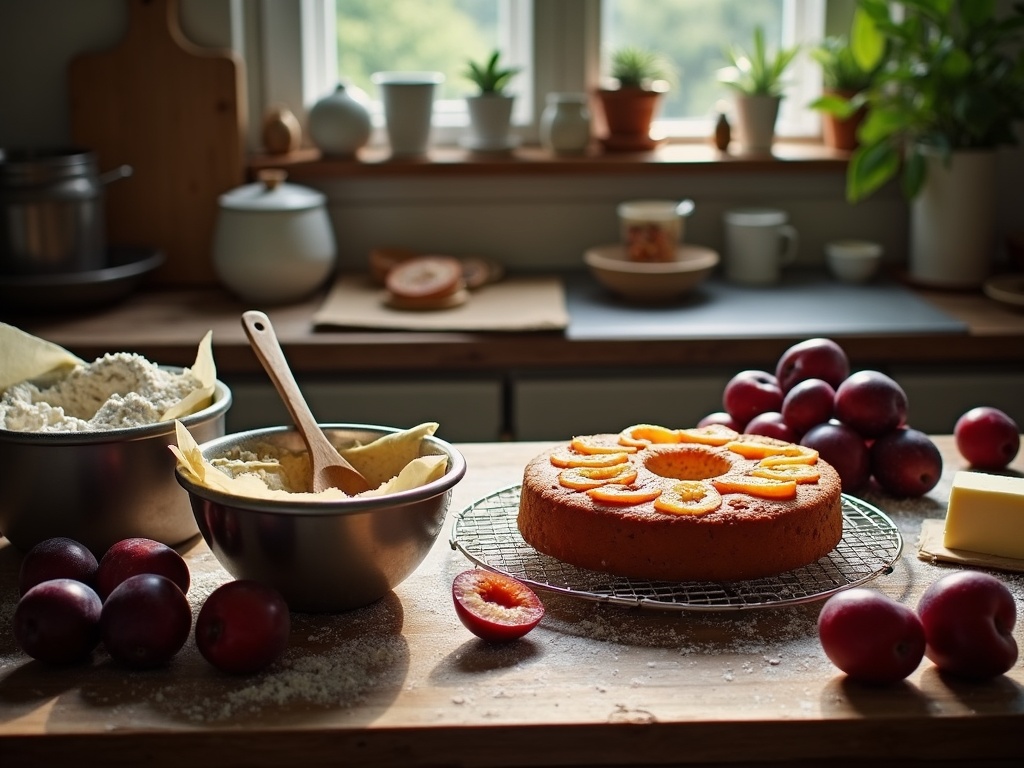
Pro Tips for the Perfect Plum Cake
Baking a plum cake might seem straightforward, but a few expert techniques can transform your dessert from good to exceptional. I’ve gathered some professional insights to help you create a stunning plum cake that will impress everyone at your table.
Selecting and Preparing Your Ingredients
Choose plums that are slightly firm but ripe for the best results. Overly soft plums can make your cake soggy, while underripe ones won’t release enough flavor. The ideal plum should yield slightly to gentle pressure and have a sweet fragrance. For a visual contrast that makes your homemade desserts stand out, consider using a mix of red and black plums.
Bringing ingredients to room temperature isn’t just baker’s folklore—it’s science. Cold eggs and butter don’t incorporate air as effectively, resulting in a denser cake. I take my ingredients out of the refrigerator at least 30 minutes before starting. This simple step creates a smoother batter and more uniform texture in your finished fruit-based dessert.
Perfecting the Baking Process
Timing is critical when baking a plum cake. Even with careful attention to the recipe’s suggested baking time, ovens vary significantly. I always test with a toothpick before removing the cake from the oven. Insert it into the center—if it comes out clean or with a few moist crumbs (but no wet batter), your cake is ready.
Patience pays off with plum cake. Let it cool completely before serving to allow the flavors to settle and the texture to set properly. I’ve found that cakes with fruit often taste even better the next day, as the fruit flavors have time to meld with the cake. For a special touch that elevates your fruit dessert, consider serving with a dollop of whipped cream or a scoop of vanilla ice cream.
The cooling process also prevents the cake from breaking apart when sliced. If you’re planning to add a glaze or dusting of powdered sugar, waiting until the cake is completely cool ensures these finishes look perfect rather than melting away.
For an extra burst of flavor in your seasonal cake recipe, try adding a touch of almond extract to complement the plums’ natural sweetness. This subtle addition pairs beautifully with the fruit and creates a professional flavor profile that will have everyone asking for your secret.
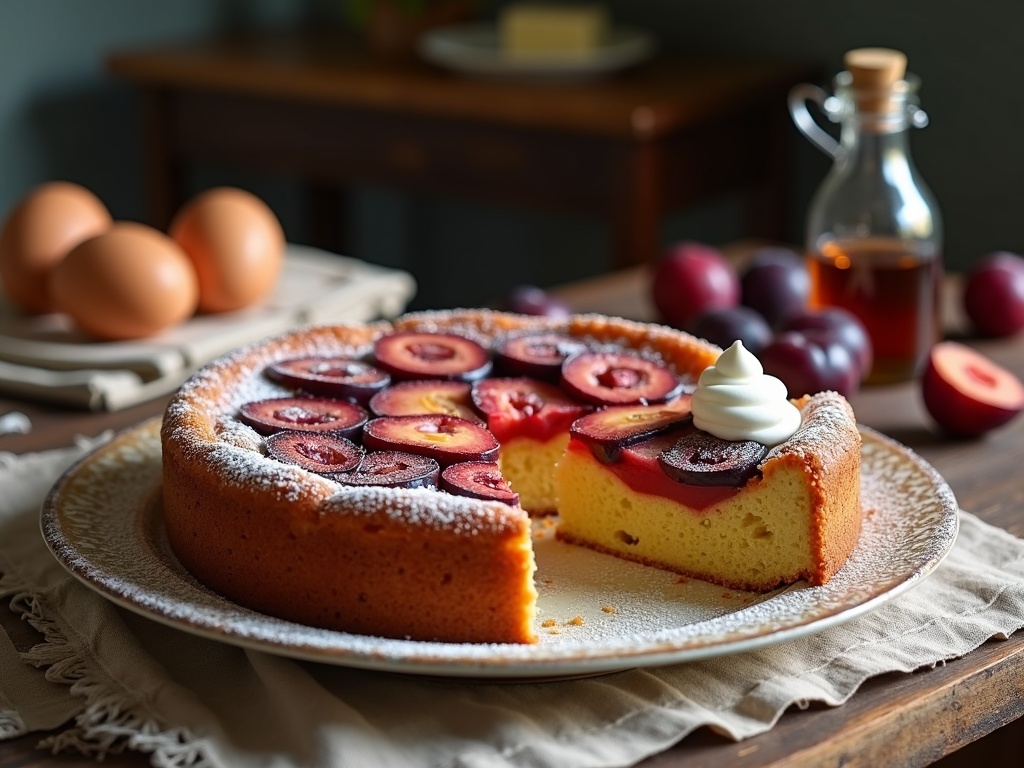
Storage and Serving Suggestions
Fresh plum cake is a delight when enjoyed right after baking, but proper storage can keep it tasting fantastic for days or even months. I’ve found that maintaining the right environment ensures your delicious dessert stays moist and flavorful.
Best Storage Practices
For short-term storage, keeping your plum cake at room temperature works perfectly. Simply place it in an airtight container or cover it tightly with plastic wrap to prevent it from drying out. The cake can stay fresh on your counter for up to 3 days, making it ideal for weekend baking that you’ll enjoy throughout the week.
If you need your cake to last longer, refrigeration is the way to go. A properly stored plum cake can maintain its quality in the refrigerator for up to a week. The cold environment slows down the growth of mold and bacteria while preserving the cake’s texture. Just remember to bring refrigerated slices back to room temperature before serving for the best flavor experience.
For long-term preservation, freezing offers an excellent solution. I recommend slicing the cake before freezing, which allows you to thaw only what you need. Wrap individual slices in plastic wrap, then aluminum foil, and store in a freezer-safe container. Your fruit-based treat will keep its quality for up to 3 months this way.
Serving Suggestions to Elevate Your Plum Cake
While plum cake is delicious on its own, you can transform it into an extraordinary dessert with a few simple additions:
- A dollop of freshly whipped cream adds lightness and complements the tartness of the plums
- A scoop of vanilla ice cream creates a wonderful hot-and-cold contrast when the cake is slightly warmed
- Custard sauce poured over a slice brings a smooth, creamy dimension to each bite
- A light dusting of powdered sugar gives visual appeal and subtle sweetness
- Greek yogurt offers a tangy alternative to cream for a less indulgent option
I particularly enjoy serving plum cake slightly warm with a scoop of melting vanilla ice cream for guests. The combination of warm, spiced cake and cold, creamy ice cream creates an irresistible contrast that’s sure to impress at any dinner party.
For brunch gatherings, try serving thin slices alongside strong coffee – the cake’s fruit-forward profile pairs beautifully with a robust brew, similar to how a strawberry dessert might be served in summer months.
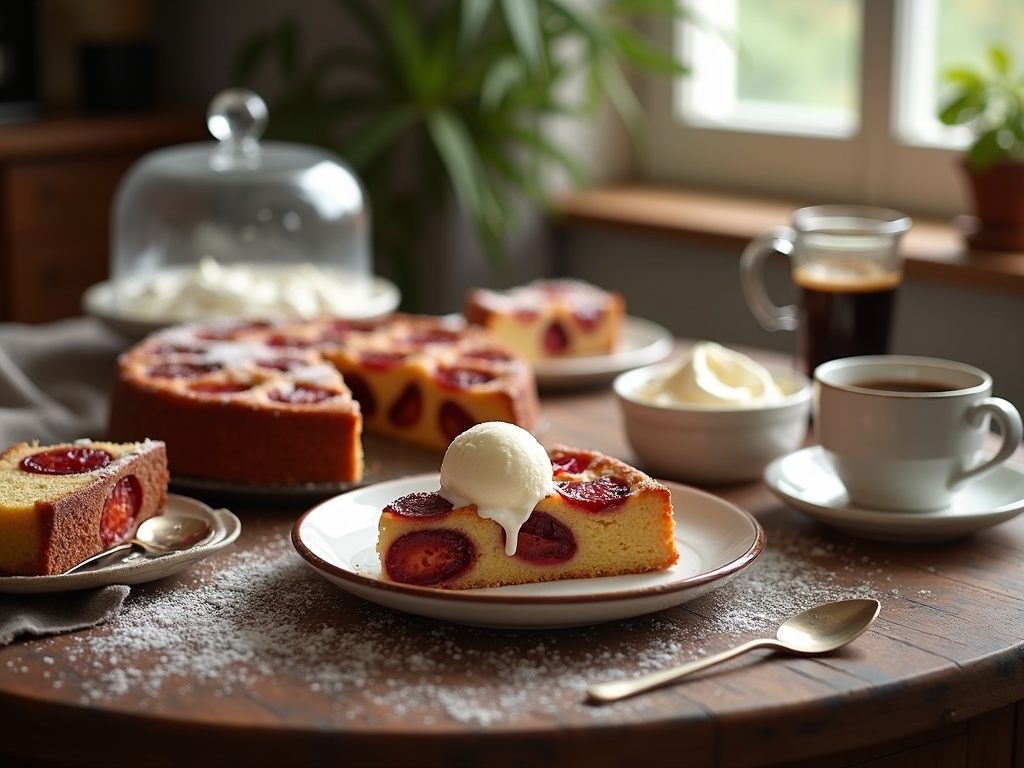
Optional Variations to Try
I’ve found that the beauty of a basic plum cake recipe lies in its versatility. While the classic version is delicious on its own, a few simple tweaks can transform this dessert into something truly special. Adding your own personal touch allows you to customize the cake based on seasonal ingredients or flavor preferences.
Flavor and Ingredient Adaptations
A splash of almond extract can take your plum cake to new heights. By adding just 1/2 teaspoon to your batter, you’ll create a sophisticated flavor profile that beautifully complements the tartness of the plums. The nutty, sweet notes of the almond extract create a wonderful depth that enhances the overall taste experience.
Don’t feel limited to plums alone! This cake recipe works brilliantly with other stone fruits, making it adaptable throughout different seasons. In late summer, try these alternatives:
- Fresh peaches for a subtle sweetness (perfect for a delicious peach dessert alternative)
- Apricots for a more delicate, honey-like flavor
- Cherries for a rich, intense taste (reminiscent of a Black Forest gateau but with a simpler approach)
- A mixed-fruit combination for a colorful, varied experience
For those who enjoy added texture, consider adding a streusel topping before baking. I mix 1/4 cup flour, 3 tablespoons brown sugar, 1/4 teaspoon cinnamon, and 2 tablespoons cold butter until crumbly, then sprinkle it over the arranged plums. This creates a beautiful contrast between the soft cake, juicy fruit, and crunchy topping – similar to what you’d find in a rhubarb crumble but with plums as the star.
For a simple yet elegant finishing touch, dust your cooled cake with powdered sugar just before serving. This adds a touch of sweetness and creates a beautiful presentation that’s perfect for special occasions. The white powder creates a lovely contrast against the deep purple plums, making it visually appealing for guests.
For a more indulgent variation, consider serving the cake with a dollop of whipped cream or vanilla ice cream. The creamy coldness pairs wonderfully with the warm cake, creating a dessert that rivals even a strawberry shortcake in terms of comfort and satisfaction.
For those who love creamy desserts, you could also develop a cream cheese glaze to drizzle over the top, similar to what you might find on a Biscoff cheesecake, but lighter to complement the fruit flavors.
Remember that plum cake, like many classic desserts, benefits from some experimentation. I often test new flavor combinations each time I bake it, sometimes adding lemon zest for brightness or a hint of cardamom for warmth. The basic recipe provides an excellent foundation for creativity.
When adapting the recipe, the key is maintaining the balance between the cake’s moistness and the fruit’s juiciness. If using particularly juicy fruits, consider tossing them with a tablespoon of flour before arranging them on the batter to prevent the cake from becoming soggy.
These variations allow you to enjoy this wonderful dessert year-round, adapting it to seasons, occasions, and personal preferences while keeping the essence of what makes plum cake so delightful.
